2nd – 5th May 2017
Tuesday 2nd
Leaving Brachina Gorge and the Flinders we’re back on the blacktop with Parachilna our first stop. The landscape has abruptly changed – flat as far as the eye can see! Parachilna’s raison d’etre was to service the old Ghan railway. A rail trolley with an information board describes its history. The railway station building is still here, though boarded up.

First the Ghan line, then the Leigh Creek coal line – both closed.
A new railway (well, by new I mean since 1956) runs through here now, but only to haul coal from Leigh Creek, a bit further north. This, too, has just closed down as mining has ceased. The new ‘Legendary Ghan’ runs on the western side of Lake Torrens.
Parachilna, though it only has a population of 2, is quite famous amongst foodies, and a ‘must stop’ spot for travellers. The Prairie Hotel, built for old Ghan travellers, is still very much a going concern, with its claim to fame being its Feral Food platters. We partook of the ‘Feral Food Antipasto’ platter and really enjoyed it. ($38, plenty for 2 to share). The emu pate was divine, though the camel mettwurst a bit chewy – note that kangaroo and emu are not ferals; for goodness sake they form our coat of arms.
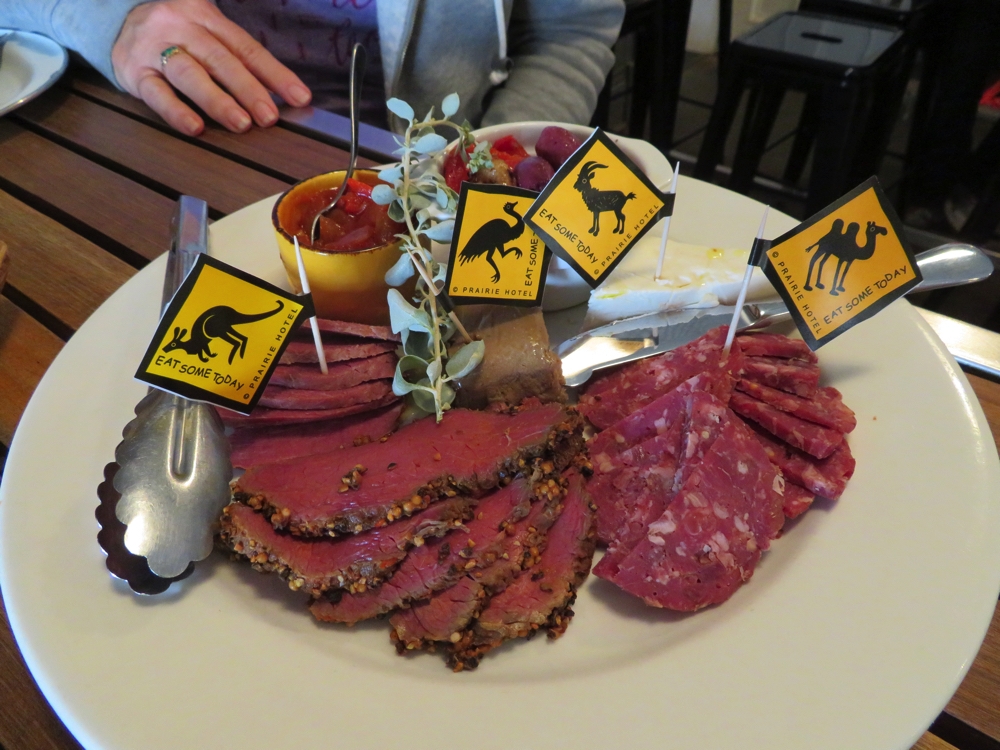
The ‘feral food’ antipasto platter. At Parachilna pub.
Heading on we turned off to stay on Beltana Station. Beltana Station was first surveyed in 1855 and soon after was purchased by Sir Thomas Elder, who then imported some of the first camels into Australia. He ran a successful breeding stud for camels and provided them for transporting supplies to remote regions or for the construction of the overland telegraph line and also for expeditions by explorers, the most notable being Ernest Giles 1875 expedition from Beltana to Perth.

Entrance to the Beltana Station.
Today Graham and Laura Ragless run the 460,000 acre sheep and cattle property. This afternoon we watched them sorting a large flock of sheep ready for transporting tomorrow (you don’t want to know where to!) and wandered the homestead grounds looking at their old and new farm machinery. Dinner tonight is in the old shearing sheds with Graham, Laura and the workers. It was a unique opportunity for us to discuss their day-to-day lives with them over a delicious roast saltbush lamb and quandong pie for dessert. Beltana only produces a few hundred sheep for wool having moved primarily into the meat market. Interestingly I noticed they unloaded a truck full of goats when we first arrived. They’re feral goats, it’s illegal to keep goats in SA, however there’s a lucrative market for goat meat in Adelaide, paying more per kilo than lamb meat. Great for the farmer; they’re controlling a problem while earning money to do so.
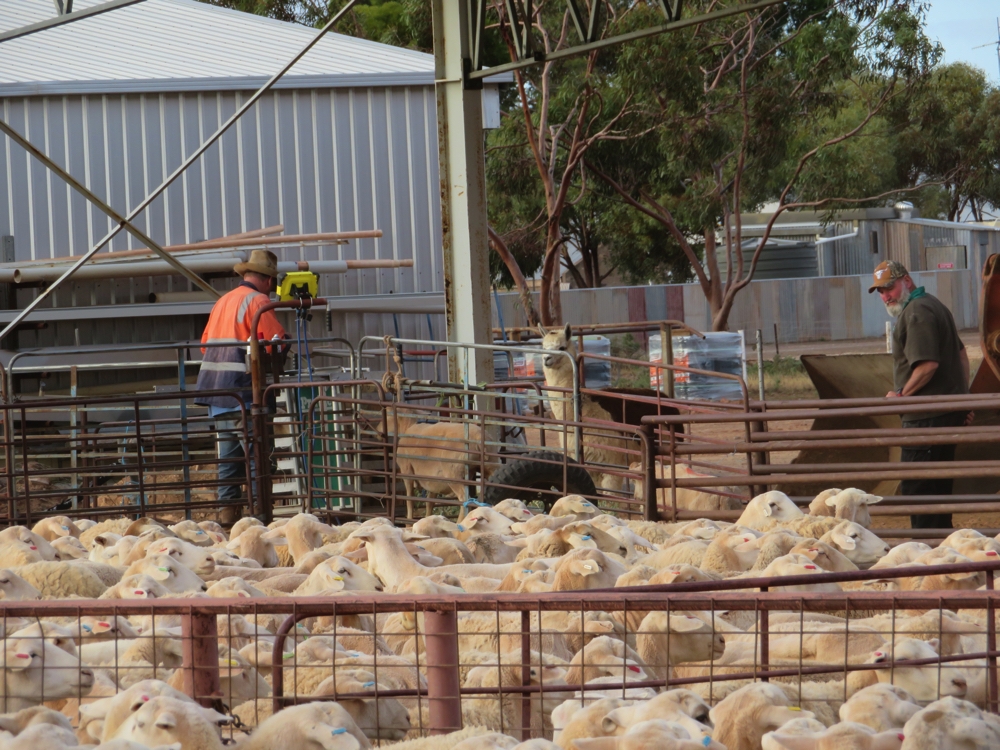
Sorting the sheep by weight – ready for sale tomorrow. Note the watchful eye of the alpaca. Beltana Station.
Wednesday 3rd
Another fantastic day today! After a wander around Beltana Station, a chat to the workers, a good look at their museum and the purchase of some saltbush lamb we drove a bit further along to the road to the old township of Beltana. Beltana had been quite a thriving town as it was the main service town until the railway was built to Marree.

This was the old railway station in Beltana. The Ghan stopped here until 1956 when the line was realigned 10km to the west as a result of the coal mine at Leigh Creek. It’s now privately owned and become someone’s home.
A notable inhabitant was the Reverent John Flynn who, during his time here realised the need for better medical services in remote areas, went on to establish what became the Royal Flying Doctor Service. This is more an ‘abandoned’ town then a ruin. It’s major buildings have been preserved and a few people still live here, though the majority of the houses are either empty or ruins. Signboards around town make for interesting reading. A brand new picnic area with covered tables and electric BBQ with excellent parking bays for campers makes me think they may be going to open it up for camping soon.
Back along the road a little way is the memorial to the Afghan cameleers.

A plaque commemorating the contribution of the Afghan cameleers to the development of central Australia.
Once more on the Outback Highway heading north we stopped for brunch at Aroona Dam which was constructed in 1955 to provide water for the Leigh Creek coal mine and community. Due to high evaporation rates out here the dam is sited in a narrow river valley with very steep sides. The geologic formations here are fascinating.
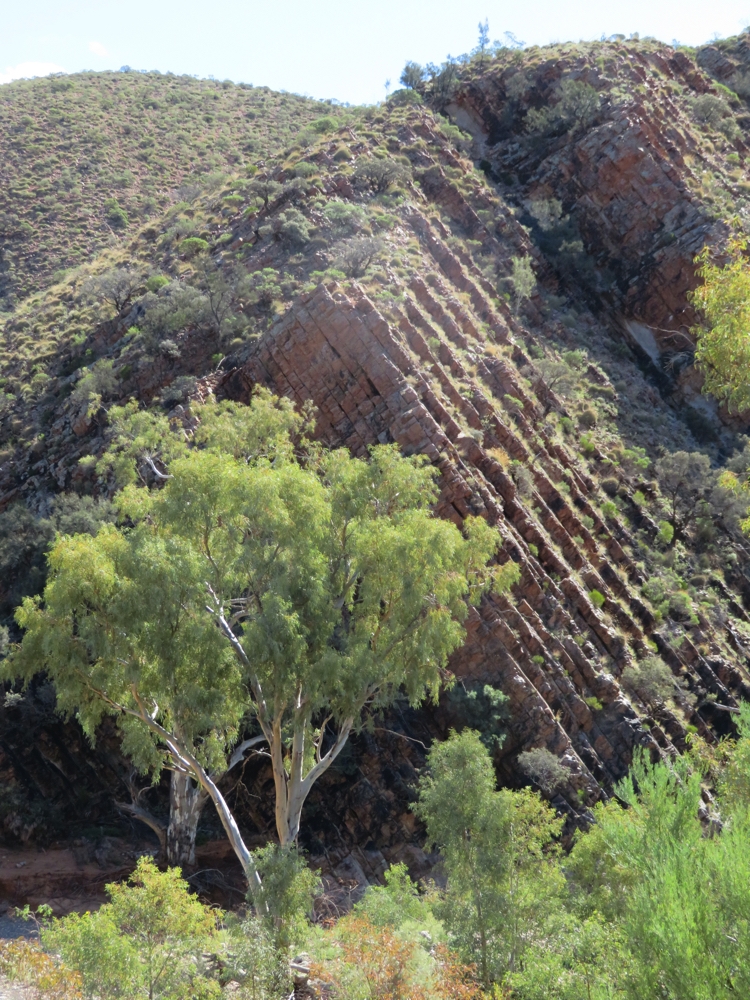
Amazing landscapes here at Aroona Dam.
On to Leigh Creek. A sense of sadness pervades the town. The coal mine, which began in the mid 1950’s closed last year and about 90% of the inhabitants have left. It’s a pretty tree-lined town that shows evidence of good urban planning, with a well-designed shopping precinct, fantastic sporting venues, parks and a modern hospital. As we drove past the lovely big school at lunchtime there were only a dozen or so children playing. The supermarket and tavern are the only places open in the shopping mall and even then we were virtually their only customers at that time. A drive through the residential areas revealed home after home empty. If we’ve learnt nothing else from this trip it’s that country areas can quickly go from boom to bust and that’s just life. But seeing all this excellent infrastructure beginning to deteriorate already is saddening, particularly when we have poor, frightened, innocent refugees housed atrociously in prisons.
We passed the mine site as we continued our travels towards Lyndhurst and Talc Alf.

Ignore these Road Restrictions at your peril. All good for this first leg of our trip.
Talc Alf some would describe as an eccentric. He lives about 5 km along the Strezlecki Track in the desert and is a gifted artist, sculpting his passion from talc which was mined nearby. Every sculpture has a message. Talc Alf is fearlessly pro-Australia but not anti-immigrant. He is also something of an iconographer interpreting meaning from the icons we use today to represent letters. It was quite fascinating listening to him and he is indeed well read and quite smart. An interesting character.

Talc Alf with just a few of his sculptures in his outdoor art gallery. Look closely at the flag on his hat.
Next stop was the Ochre Pits. This ochre has been ‘mined’ here for thousands of years by the indigenous people who use it ceremonially and for trading.

Ochre pits. Amazing how large they are.
By now dusk was approaching, but we decided to continue on to the campsite at Farina ($5/pp/n) some 25km up the road, where we arrived just before sunset. Chilly night, only 2C just before sunrise.
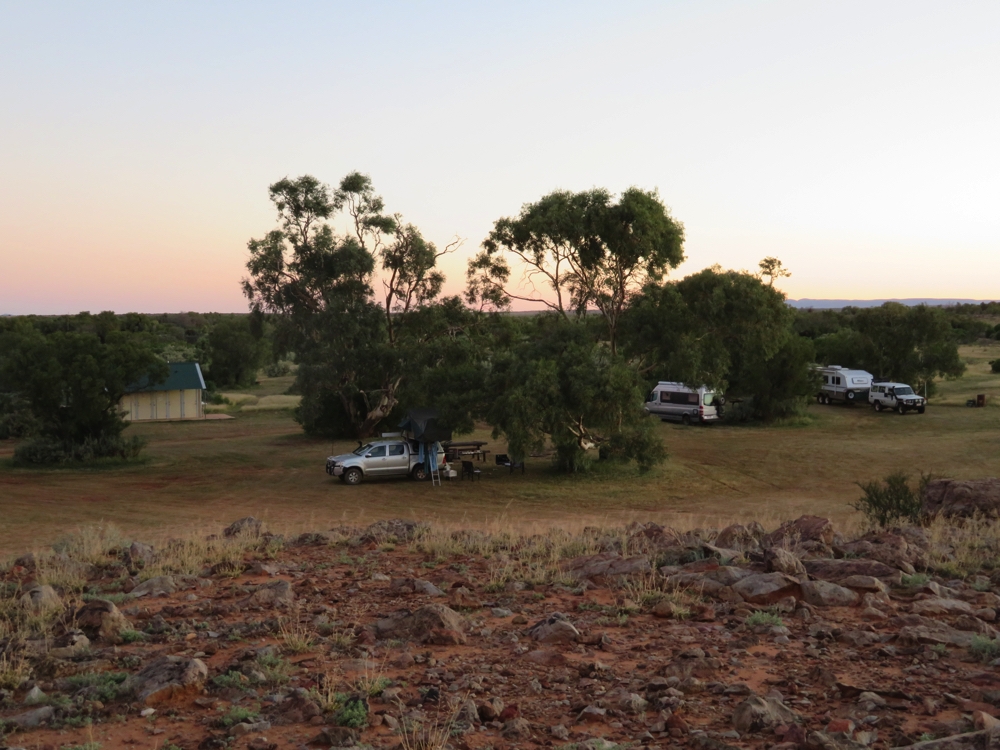
Our campsite at Farina at sunset – a delightfully unexpected treat.
Thursday 4th
If yesterday was a great day for all the interesting things we saw as we travelled, today was a great day for the relaxation and beauty of just staying put. Farina began in 1878 and was named as such because of the unrealised hope it would be a wheat producing area (farina is Latin for wheat). It’s heyday coincided with the progress of the Ghan train line up to here and its demise began soon after as the Ghan line was being built further north taking the workers with it, and the arrival of automobiles for transport replacing the camel trains which originated around these parts. It’s now a town of only ruined buildings, but has one of the best campsites ever just outside it along the creek. It’s a very large camping area, with green grass – let me say that again – with green grass, large shady trees, flushing toilets and a donkey-heated hot shower, and did I mention it’s all grassed, with green grass. We’d only planned to stay one night, but our next stop will be on dirt behind a pub … why move!!

Ahh a bit of well deserved R&R. At Farina campsite. Note the picnic table – seating and table made from old Ghan sleepers, while the support posts are railway lines. Very sturdy!
Apart from the beauty of the campsite the town of Farina has received lots of TLC from volunteers who are restoring some of the buildings and have placed really interesting information boards all around town describing what stood in that spot, but also the day-to-day lives of the inhabitants as described by them. If you’re a traveller don’t even think of bypassing this gem.

Partially restored buildings in Farina.
After a lengthy exploration of the town ruins I did some cooking to have more ready-made meals prepared for the coming two weeks and Steve did some geocaching, finding the two geocaches hidden here. Later in the afternoon he lit the fire in the donkey to heat water for showers, much to the approval of the other campers, then we BBQ’d our dinner.

BBQ for dinner tonight. At Farina campsite.
Friday 5th
A few hundred metres outside the town are the rail yards. The bridge over the creek still stands as well as the large square water tank, and evidence of where the narrow gauge and wide gauge rails ran is clear. Piles of rubble indicate where other buildings, such as the Booking Office, the waiting rooms, etc once stood.

The water tower at Farina railway siding. This style of cast iron tank is common at the Ghan sidings – the water being used to refill the steam engines.
Cattle, wool and ore from the local mines were taken to Adelaide from here; Thomas Kidman’s cattle were brought down to here or Beltana by drovers before being loaded on the train.

Stuart’s contribution to opening up central Australia is commemorated. His expeditions permitted not only communication from south to north, but also settlements and farming.
At Maree, not too much further up the road, we’re meeting Ken and Wendy, fellow Trakka Jabiru owners, who we’ll be travelling with for the next 6 weeks or so. We camped at the back of the pub (free camp). Here I had my first bore water shower – it’s not that bad, but too salty to drink. While waiting for them we wandered around Maree, not a town in ruins for a change! The Ghan’s last departure from here was in November 1981, then the railway closed. However the railway buildings are still in good condition.

The old Ghan lines have been retained here in Marree, and the railway station is in good repair. Some of the buildings have been repurposed and continue to serve the community.
In the pub is the Tom Kruse museum. Tom was the very well liked and respected ‘mailman’ who in the 1930’s to 1950’s delivered the mail and goods to the properties along the Birdsville Track, which begins here. Not an easy job.
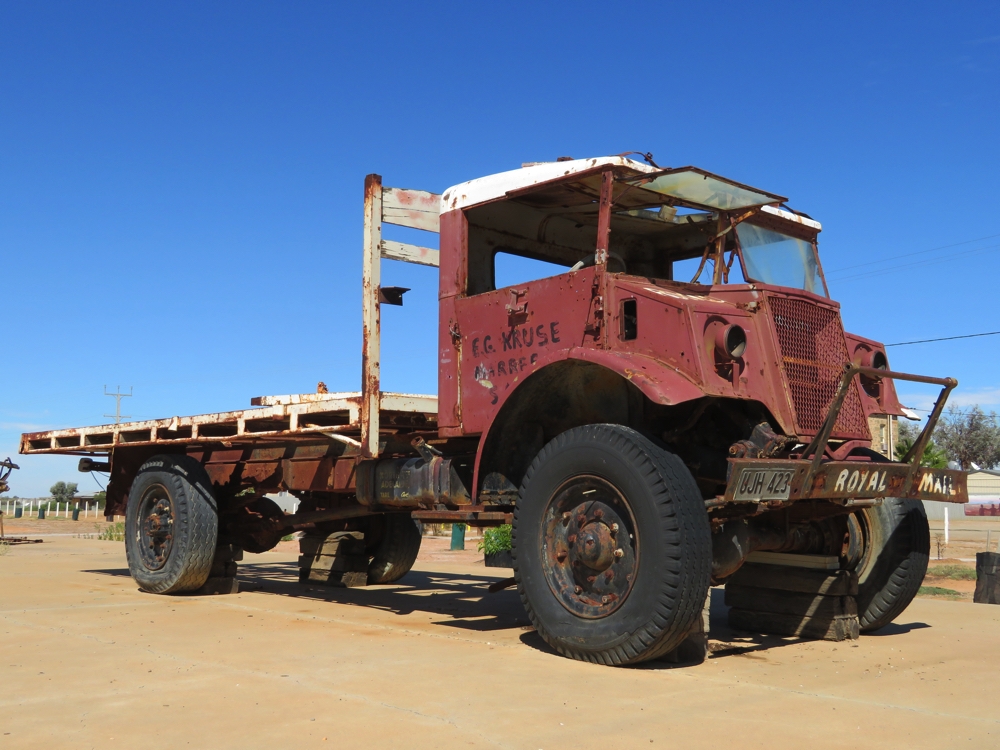
Tom Kruse’s contribution to outback people is not forgotten – here is the truck he used to deliver the mail and supplies along the Birdsville Track. There’s also a museum of photos, memorabilia and a short documentary that was interesting to view. Altogether a pretty amazing man.
Tomorrow we begin the Oodnadatta Track with Ken and Wendy.
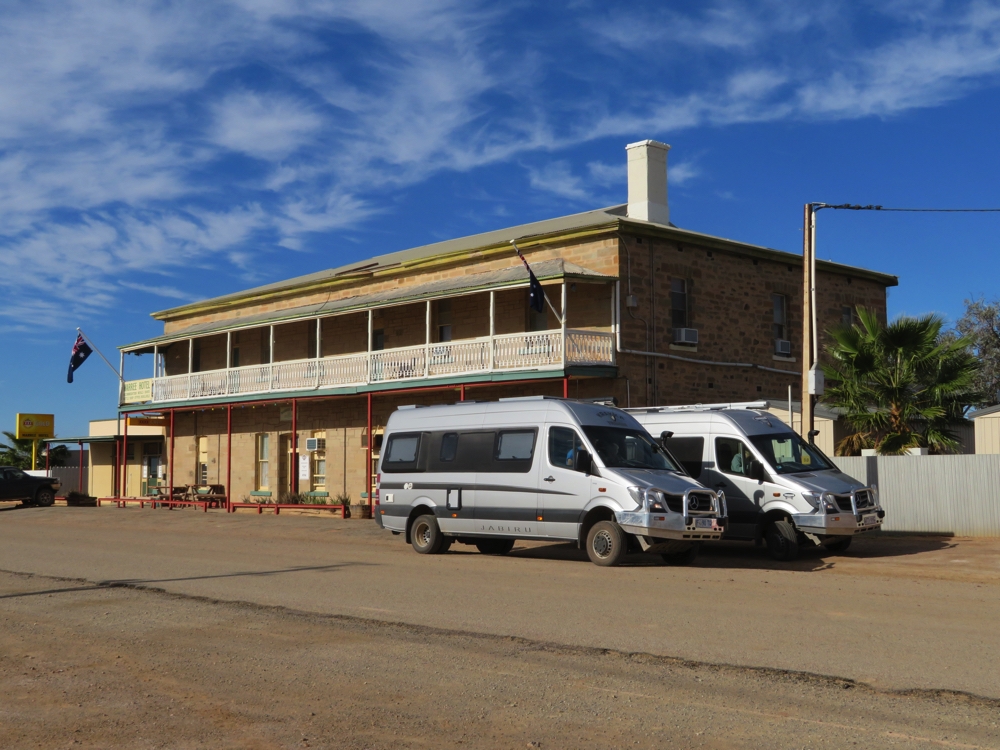
The two Trakkas ready to leave from the Maree pub.
For more photos from this part of our trip CLICK HERE.